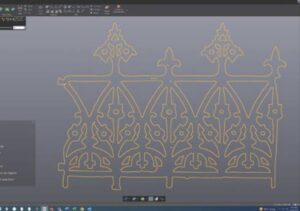Sometimes it takes the latest technology to restore some of the oldest things.
CIRAS recently partnered with ALMACO in Nevada to recreate ornate metalwork on Nevada’s Briggs Terrace-Evergreen Lane house, which was built in 1879 and is on the National Historic Register. During the 2020 derecho, a tree fell into the front porch, damaging its cresting—decorative metal ornamentation that looks like tiny wrought iron fencing but is used along the tops of Victorian roofs. The matching cresting on the very top of the house was not damaged, so finding salvage to replace the cresting on the porch wasn’t an option.
The Nevada Historical Society, which owns the house, connected with ALMACO for assistance. Founded in 1884 as a blacksmith shop, ALMACO is the oldest business in Story County. Today it creates custom planting and harvesting solutions for seed research as well as manufacturing and engineering services.

ALMACO was happy to help. “Our community gives us so much every year. We’re always looking for ways to give right back,” said Mark Smith, chief execution officer.
A community member brought part of the cresting to ALMACO to determine if they could recreate it. Smith told them using the original method of casting iron was prohibitively expensive, but he was confident that CIRAS had the right technology to produce something similar at a fraction of the cost.
CIRAS was indeed able to help. Jake Behrens, CIRAS project manager, used a 3D laser scanner to create a digital model of the ornate ironwork. CIRAS then extracted information from the scan to create a 2D CAD drawing of the parts. After that, ALMACO used the digital file to program their computerized laser cutter to replicate the same outline from sheet steel.
The collaboration resulted in a cresting that has less detail on the front and back than the original, but with a fully accurate silhouette to create the desired effect.
Smith said it’s not the first time ALMACO has worked with CIRAS. “When we have a problem that is more complex than what we normally deal with, we engage CIRAS. Even if we think we may know the answer, it gives us great confidence in the decisions we are making.”
Smith, who donated materials and labor for the project, likes being able to use innovation to support community historical efforts.
For more information, contact Jake Behrens at jbehrens@iastate.edu or 515-815-5003.